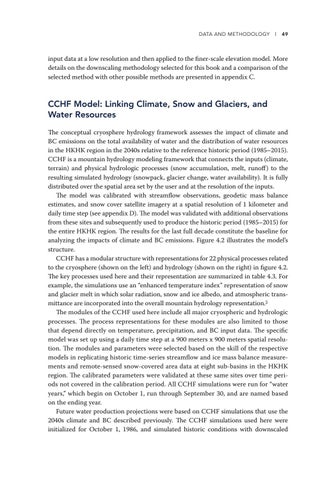Data and Methodology l 49
input data at a low resolution and then applied to the finer-scale elevation model. More details on the downscaling methodology selected for this book and a comparison of the selected method with other possible methods are presented in appendix C.
CCHF Model: Linking Climate, Snow and Glaciers, and Water Resources The conceptual cryosphere hydrology framework assesses the impact of climate and BC emissions on the total availability of water and the distribution of water resources in the HKHK region in the 2040s relative to the reference historic period (1985–2015). CCHF is a mountain hydrology modeling framework that connects the inputs (climate, terrain) and physical hydrologic processes (snow accumulation, melt, runoff ) to the resulting simulated hydrology (snowpack, glacier change, water availability). It is fully distributed over the spatial area set by the user and at the resolution of the inputs. The model was calibrated with streamflow observations, geodetic mass balance estimates, and snow cover satellite imagery at a spatial resolution of 1 kilometer and daily time step (see appendix D). The model was validated with additional observations from these sites and subsequently used to produce the historic period (1985–2015) for the entire HKHK region. The results for the last full decade constitute the baseline for analyzing the impacts of climate and BC emissions. Figure 4.2 illustrates the model’s structure. CCHF has a modular structure with representations for 22 physical processes related to the cryosphere (shown on the left) and hydrology (shown on the right) in figure 4.2. The key processes used here and their representation are summarized in table 4.3. For example, the simulations use an “enhanced temperature index” representation of snow and glacier melt in which solar radiation, snow and ice albedo, and atmospheric transmittance are incorporated into the overall mountain hydrology representation.5 The modules of the CCHF used here include all major cryospheric and hydrologic processes. The process representations for these modules are also limited to those that depend directly on temperature, precipitation, and BC input data. The specific model was set up using a daily time step at a 900 meters x 900 meters spatial resolution. The modules and parameters were selected based on the skill of the respective models in replicating historic time-series streamflow and ice mass balance measurements and remote-sensed snow-covered area data at eight sub-basins in the HKHK region. The calibrated parameters were validated at these same sites over time periods not covered in the calibration period. All CCHF simulations were run for “water years,” which begin on October 1, run through September 30, and are named based on the ending year. Future water production projections were based on CCHF simulations that use the 2040s climate and BC described previously. The CCHF simulations used here were initialized for October 1, 1986, and simulated historic conditions with downscaled




